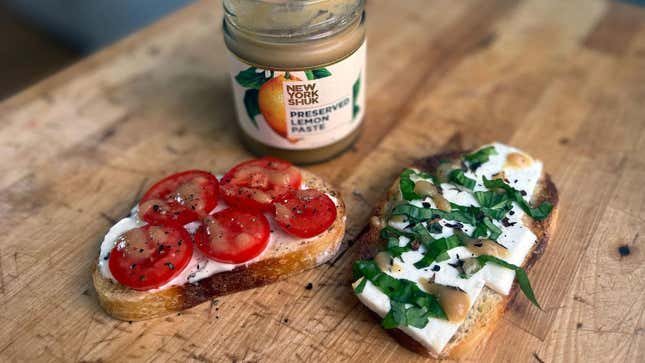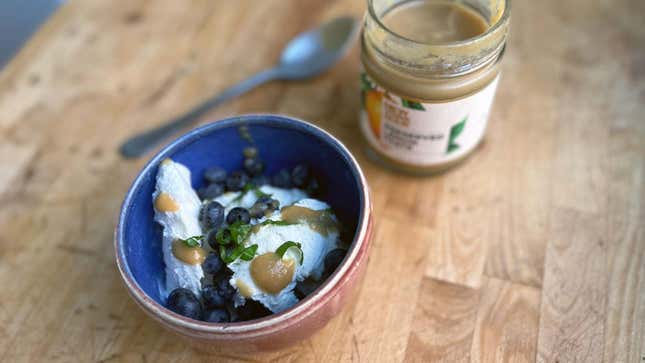
When you discover one of those “special” condiments, it becomes part of your kitchen identity and you’ll preach it to anyone who’ll listen. I have an ex who applied liberal amounts of sriracha to everything from popcorn to avocado toast. My neighbors found Boat Sauce at a local bodega and swear by it for dipping and topping nearly every food. And I have a friend who is now collecting Ace Hardware coupons because that’s where he found his new favorite hot sauce.
Now I’ve finally found my own signature condiment: preserved lemon paste. She’s perfect. I read about it on The Strategist, the New York magazine vertical that has truly never steered me wrong—and I’ve probably banked the publication a small fortune by smashing its affiliate links.
I tracked down the lemon paste at a local specialty shop and have added it to nearly everything I’ve eaten in the 24 hours I’ve owned it. You’ll almost always win me over with lemon—I’m a dumb loser who even tattooed a lemon on her arm—but this stuff totally exceeded my expectations.
What is preserved lemon paste?
Preserved lemon paste is just lemons and salt. More specifically, we’re talking brined lemons that have been pureed. New York Shuk seems to be the go-to brand for the paste, which is the version I purchased and what both The Strategist and The New York Times have hyped. It’s somewhat looser than a curd in texture, but tastes absolutely nothing like a dessert filling. It’s sour and it’s salty.
But what’s so special about this paste is how much its flavor profile changes each time you pair it with something new. It’s actually kind of remarkable how much it shifted with each dish I tried it in. Like listening to a new favorite album in different environments, it hits a little different each time—but it’s still a banger.
Stir preserved lemon paste into water
I begin each morning with a warm glass of water with a splash of lemon juice before mainlining coffee, so I wanted to start my little adventure by adding the paste to plain water. For having such a strong flavor on its own, it mellows pretty drastically when diluted.
It dawned on me that the citrus and salt from the paste could actually turn plain water into a classy glass of Gatorade. And I was right. It was shockingly refreshing when I drank it after a really sweaty run, presumably helping me replenish whatever electrolytes I lost. I’m almost looking forward to my next hangover to see if it could be my fancy new Pedialyte.
Drizzle preserved lemon paste over mild cheese
I made two different toasts and added the lemon paste to each, with stellar results.
First I put lightly oiled bread topped with a soft Greek cheese under the broiler. I pulled it out and added a little of the paste, chopped basil, and some fancy crushed pepper. The cheese wasn’t too salty, which allowed the paste to do most of the seasoning. The lemon-basil combination was incredibly fresh, and it tasted the way the Amalfi Coast looks. I wanted to pair it with cured meat, some olives, and a spritz. I wanted to serve it to Paul Newman on a boat in Venice in 1963.
Pair preserved lemon paste with tomatoes
I made a second toast that I topped with a healthy swipe of mayo, a tomato from my balcony (I am a farmer), the lemon paste, and some fresh cracked pepper. And I don’t know if I’ve ever tasted anything so bright. The tomato and lemon popped and I want to eat this every day for the rest of my life. Zero edits.

Make a preserved lemon paste cocktail
Dirty martini? Or with a twist? Preserved lemon paste lets you say, “Why not both?”
This was finally a dirty-ish martini I could get into. I always opt for a martini with a twist (gin, never vodka) but this played up the brightness of the lemon, which wasn’t overpowered by the briny notes of the salt-booze combination. Plus there was still the floral undertone of the gin. It was one of the most well-rounded cocktails I’ve ever made at home.
I also tried the paste with mezcal, honey, and seltzer water—like a paloma where the salt from the rim fell into the glass itself. The touch of honey is crucial, because this paste doesn’t run sweet really at all. It was funky in a very good way. The lemon paste brought out an almost cedar-like flavor to the mezcal, something between floral and woody.

Add preserved lemon paste to ice cream
This was what I was most excited to try, but of all the pairings, ice cream definitely brought out the paste’s salty components the most. Which, if you’re someone who likes some nice, fat flecks of salt on your chocolate chip cookies like I do, will not be a bad thing. But do tread lightly.
Drizzle that paste over a vanilla bean ice cream, add a handful of berries, some basil, mush it all up, and call it a day. In any of these recipes, a little paste goes a very long way to change the entire dish, so for 16 bucks a jar, it’s more of a steal than you think.